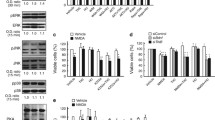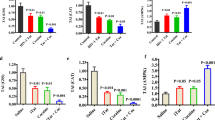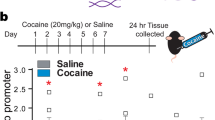Abstract
Cocaine abuse represents an immense societal health and economic burden for which no effective treatment currently exists. Among the numerous intracellular signaling cascades impacted by exposure to cocaine, increased and aberrant production of pro-inflammatory cytokines in the CNS has been observed. Additionally, we have previously reported a decrease in retinoid-X-receptor-gamma (RXR-γ) in brains of mice chronically exposed to cocaine. Through obligate heterodimerization with a number of nuclear receptors, RXRs serve as master regulatory transcription factors, which can potentiate or suppress expression of a wide spectrum of genes. Little is known about the regulation of RXR levels, but previous studies indicate cellular stressors such as cytokines negatively regulate levels of RXRs in vitro. To evaluate the mechanism underlying the cocaine-induced decreases in RXR-γ levels observed in vivo, we exposed neurons to cocaine in vitro and examined pathways which may contribute to disruption in RXR signaling, including activation of stress pathways by cytokine induction. In these studies, we provide the first evidence that cocaine exposure disrupts neuronal RXR-γ signaling in vitro by promoting its nuclear export and degradation. Furthermore, we demonstrate this effect may be mediated, at least in part, by cocaine-induced production of TNF-α and its downstream effector c-Jun-NH-terminal kinase (JNK). Findings from this study are therefore applicable to both cocaine abuse and to pathological conditions characterized by neuroinflammatory factors, such as neurodegenerative disease.








Similar content being viewed by others
Abbreviations
- RXR-γ:
-
retinoid-X-receptor-gamma
- JNK:
-
c-Jun-NH-terminal kinase
- p-JNK:
-
phosphorylated JNK
- TNF-α:
-
tumor-necrosis-factor-alpha
- Bort:
-
Bortezomib
References
Achim CL, Heyes MP, Wiley CA (1993) Quantitation of human immunodeficiency virus, immune activation factors, and quinolinic acid in AIDS brains. J Clin Invest 91(6):2769–2775
Adachi S, Okuno M, Matsushima-Nishiwaki R, Takano Y, Kojima S, Friedman SL, Moriwaki H, Okano Y (2002) Phosphorylation of retinoid X receptor suppresses its ubiquitination in human hepatocellular carcinoma. Hepatology (Baltimore, Md) 35(2):332–340
Adam-Stitah S, Penna L, Chambon P, Rochette-Egly C (1999) Hyperphosphorylation of the retinoid X receptor alpha by activated c-Jun NH2-terminal kinases. J Biol Chem 274(27):18932–18941
Ahluwalia MS (2011) 2010 society for neuro-oncology annual meeting: a report of selected studies. Expert Rev Anticancer Ther 11(2):161–163
Allan SM, Rothwell NJ (2001) Cytokines and acute neurodegeneration. Nature Rev 2(10):734–744
Bastien J, Rochette-Egly C (2004) Nuclear retinoid receptors and the transcription of retinoid-target genes. Gene 328:1–16
Biedler JL, Helson L, Spengler BA (1973) Morphology and growth, tumorigenicity, and cytogenetics of human neuroblastoma cells in continuous culture. Cancer Res 33(11):2643–2652
Bogoyevitch MA, Kobe B (2006) Uses for JNK: the many and varied substrates of the c-Jun N-terminal kinases. Microbiol Mol Biol Rev: MMBR 70(4):1061–1095
Borland MK, Trimmer PA, Rubinstein JD, Keeney PM, Mohanakumar K, Liu L, Bennett JP Jr (2008) Chronic, low-dose rotenone reproduces Lewy neurites found in early stages of Parkinson’s disease, reduces mitochondrial movement and slowly kills differentiated SH-SY5Y neural cells. Mol Neurodegener 3:21
Boudjelal M, Wang Z, Voorhees JJ, Fisher GJ (2000) Ubiquitin/proteasome pathway regulates levels of retinoic acid receptor gamma and retinoid X receptor alpha in human keratinocytes. Cancer Res 60(8):2247–2252
Clark KH, Wiley CA, Bradberry CW (2013) Psychostimulant abuse and neuroinflammation: emerging evidence of their interconnection. Neurotox Res 23(2):174–188
Connor MJ, Sidell N (1997) Retinoic acid synthesis in normal and Alzheimer diseased brain and human neural cells. Mol Chem Neuropathol / sponsored by the Int Soc for Neurochem and the World Federation of Neurology and research groups on neurochemistry and cerebrospinal fluid 30(3):239–252
Costa BM, Yao H, Yang L, Buch S (2013) Role of endoplasmic reticulum (ER) stress in cocaine-induced microglial cell death. J Neuroimmune Pharmacol 8(3):705–714
Cramer PE, Cirrito JR, Wesson DW, Lee CY, Karlo JC, Zinn AE, Casali BT, Restivo JL, Goebel WD, James MJ et al (2012) ApoE-directed therapeutics rapidly clear beta-amyloid and reverse deficits in AD mouse models. Science (New York, NY) 335(6075):1503–1506
Crawford FC, Wood ML, Wilson SE, Mathura VS, Hollen TR, Geall F, Kolippakkam DN, Mullan MJ (2006) Cocaine induced inflammatory response in human neuronal progenitor cells. J Neurochem 97(3):662–674
Crews FT, Zou J, Qin L (2011) Induction of innate immune genes in brain create the neurobiology of addiction. Brain Behav Immun 25(Suppl 1):S4–S12
de Urquiza AM, Liu S, Sjoberg M, Zetterstrom RH, Griffiths W, Sjovall J, Perlmann T (2000) Docosahexaenoic acid, a ligand for the retinoid X receptor in mouse brain. Science (New York, NY) 290(5499):2140–2144
Dey S, Snow DM (2007) Cocaine exposure in vitro induces apoptosis in fetal locus coeruleus neurons through TNF-alpha-mediated induction of Bax and phosphorylated c-Jun NH(2)-terminal kinase. J Neurochem 103(2):542–556
Evans SM, Cone EJ, Henningfield JE (1996) Arterial and venous cocaine plasma concentrations in humans: relationship to route of administration, cardiovascular effects and subjective effects. J Pharmacol Exp Ther 279(3):1345–1356
Farooqui T, Farooqui AA (2011) Lipid-mediated oxidative stress and inflammation in the pathogenesis of Parkinson’s disease. Parkinson’s Dis 2011:247467
Ferris MJ, Mactutus CF, Booze RM (2008) Neurotoxic profiles of HIV, psychostimulant drugs of abuse, and their concerted effect on the brain: current status of dopamine system vulnerability in NeuroAIDS. Neurosci Biobehav Rev 32(5):883–909
Glantz LA, Gilmore JH, Hamer RM, Lieberman JA, Jarskog LF (2007) Synaptophysin and postsynaptic density protein 95 in the human prefrontal cortex from mid-gestation into early adulthood. Neuroscience 149(3):582–591
Gomez-Santos C, Francisco R, Gimenez-Xavier P, Ambrosio S (2007) Dopamine induces TNFalpha and TNF-R1 expression in SH-SY5Y human neuroblastoma cells. Neuroreport 18(16):1725–1728
Hellmann-Regen J, Kronenberg G, Uhlemann R, Freyer D, Endres M, Gertz K (2013) Accelerated degradation of retinoic acid by activated microglia. J Neuroimmunol 256(1–2):1–6
Hewson QC, Lovat PE, Pearson AD, Redfern CP (2002) Retinoid signalling and gene expression in neuroblastoma cells: RXR agonist and antagonist effects on CRABP-II and RARbeta expression. J Cell Biochem 87(3):284–291
Huang JK, Jarjour AA, Nait Oumesmar B, Kerninon C, Williams A, Krezel W, Kagechika H, Bauer J, Zhao C, Evercooren AB et al (2011) Retinoid X receptor gamma signaling accelerates CNS remyelination. Nat Neurosci 14(1):45–53
Husson M, Enderlin V, Alfos S, Boucheron C, Pallet V, Higueret P (2004) Expression of neurogranin and neuromodulin is affected in the striatum of vitamin A-deprived rats. Brain Res Mol Brain Res 123(1–2):7–17
Iniguez MA, Rodriguez-Pena A, Ibarrola N, Aguilera M, Munoz A, Bernal J (1993) Thyroid hormone regulation of RC3, a brain-specific gene encoding a protein kinase-C substrate. Endocrinology 133(2):467–473
Karin M (1996) The regulation of AP-1 activity by mitogen-activated protein kinases. Philos Trans R Soc Lond B Biol Sci 351(1336):127–134
Karter DL, Karter AJ, Yarrish R, Patterson C, Kass PH, Nord J, Kislak JW (1995) Vitamin A deficiency in non-vitamin-supplemented patients with AIDS: a cross-sectional study. J Acquir Immune Defic Syndr Hum Retrovirol: Off Publ Int Retrovirol Assoc 8(2):199–203
Kim MS, Sweeney TR, Shigenaga JK, Chui LG, Moser A, Grunfeld C, Feingold KR (2007) Tumor necrosis factor and interleukin 1 decrease RXRalpha, PPARalpha, PPARgamma, LXRalpha, and the coactivators SRC-1, PGC-1alpha, and PGC-1beta in liver cells. Metab Clin Exp 56(2):267–279
Kliewer SA, Umesono K, Mangelsdorf DJ, Evans RM (1992) Retinoid X receptor interacts with nuclear receptors in retinoic acid, thyroid hormone and vitamin D3 signalling. Nature 355(6359):446–449
Kosters A, White DD, Sun H, Thevananther S, Karpen SJ (2009) Redundant roles for cJun-N-terminal kinase 1 and 2 in interleukin-1beta-mediated reduction and modification of murine hepatic nuclear retinoid X receptor alpha. J Hepatol 51(5):898–908
Kousik SM, Napier TC, Carvey PM (2012) The effects of psychostimulant drugs on blood brain barrier function and neuroinflammation. Front Pharmacol 3:121
Kovalevich J, Langford D (2013) Considerations for the use of SH - SY5Y neuroblastoma cells in neurobiology. In: Amini S, White MK (eds) Neuronal Cell Culture: Methods and Protocols, Methods in Molecular Biology, vol 1078, 1st edn. Springer, New York, pp 9–21
Kovalevich J, Corley G, Yen W, Kim J, Rawls S, Langford D (2012a) Cocaine decreases expression of neurogranin via alterations in thyroid receptor/retinoid X receptor signaling. J Neurochem 121(2):302–313
Kovalevich J, Corley G, Yen W, Rawls SM, Langford D (2012b) Cocaine-induced loss of white matter proteins in the adult mouse nucleus accumbens is attenuated by administration of a beta-lactam antibiotic during cocaine withdrawal. Am J Pathol 181(6):1921–1927
Krezel W, Ghyselinck N, Samad TA, Dupe V, Kastner P, Borrelli E, Chambon P (1998) Impaired locomotion and dopamine signaling in retinoid receptor mutant mice. Science (New York, NY) 279(5352):863–867
Krzyzosiak A, Szyszka-Niagolov M, Wietrzych M, Gobaille S, Muramatsu S, Krezel W (2010) Retinoid x receptor gamma control of affective behaviors involves dopaminergic signaling in mice. Neuron 66(6):908–920
Kuhn DM, Francescutti-Verbeem DM, Thomas DM (2006) Dopamine quinones activate microglia and induce a neurotoxic gene expression profile: relationship to methamphetamine-induced nerve ending damage. Ann N Y Acad Sci 1074:31–41
Kume T, Kawato Y, Osakada F, Izumi Y, Katsuki H, Nakagawa T, Kaneko S, Niidome T, Takada-Takatori Y, Akaike A (2008) Dibutyryl cyclic AMP induces differentiation of human neuroblastoma SH-SY5Y cells into a noradrenergic phenotype. Neurosci Lett 443(3):199–203
Lee HY, Walsh GL, Dawson MI, Hong WK, Kurie JM (1998) All-trans-retinoic acid inhibits Jun N-terminal kinase-dependent signaling pathways. J Biol Chem 273(12):7066–7071
Lee HY, Suh YA, Robinson MJ, Clifford JL, Hong WK, Woodgett JR, Cobb MH, Mangelsdorf DJ, Kurie JM (2000) Stress pathway activation induces phosphorylation of retinoid X receptor. J Biol Chem 275(41):32193–32199
Lee YW, Hennig B, Fiala M, Kim KS, Toborek M (2001) Cocaine activates redox-regulated transcription factors and induces TNF-alpha expression in human brain endothelial cells. Brain Res 920(1–2):125–133
Lee CT, Chen J, Hayashi T, Tsai SY, Sanchez JF, Errico SL, Amable R, Su TP, Lowe RH, Huestis MA et al (2008) A mechanism for the inhibition of neural progenitor cell proliferation by cocaine. PLoS Med 5(6):e117
Lepsch LB, Munhoz CD, Kawamoto EM, Yshii LM, Lima LS, Curi-Boaventura MF, Salgado TM, Curi R, Planeta CS, Scavone C (2009) Cocaine induces cell death and activates the transcription nuclear factor kappa-B in PC12 cells. Mol Brain 2:3
Li J, Molkentin JD, Colbert MC (2001) Retinoic acid inhibits cardiac neural crest migration by blocking c-Jun N-terminal kinase activation. Dev Biol 232(2):351–361
Macoritto M, Nguyen-Yamamoto L, Huang DC, Samuel S, Yang XF, Wang TT, White JH, Kremer R (2008) Phosphorylation of the human retinoid X receptor alpha at serine 260 impairs coactivator(s) recruitment and induces hormone resistance to multiple ligands. J Biol Chem 283(8):4943–4956
Mangelsdorf DJ, Evans RM (1995) The RXR heterodimers and orphan receptors. Cell 83(6):841–850
Mangelsdorf DJ, Thummel C, Beato M, Herrlich P, Schutz G, Umesono K, Blumberg B, Kastner P, Mark M, Chambon P et al (1995) The nuclear receptor superfamily: the second decade. Cell 83(6):835–839
Masliah E, Terry RD, Alford M, DeTeresa R (1990) Quantitative immunohistochemistry of synaptophysin in human neocortex: an alternative method to estimate density of presynaptic terminals in paraffin sections. J Histochem Cytochem : Off J Histochem Soc 38(6):837–844
Masserano JM, Baker I, Venable D, Gong L, Zullo SJ, Merril CR, Wyatt RJ (2000) Dopamine induces cell death, lipid peroxidation and DNA base damage in a catecholaminergic cell line derived from the central nervous system. Neurotox Res 1(3):171–179
Matsumoto RR, Hewett KL, Pouw B, Bowen WD, Husbands SM, Cao JJ, Hauck Newman A (2001) Rimcazole analogs attenuate the convulsive effects of cocaine: correlation with binding to sigma receptors rather than dopamine transporters. Neuropharmacology 41(7):878–886
Matsumoto RR, McCracken KA, Pouw B, Zhang Y, Bowen WD (2002) Involvement of sigma receptors in the behavioral effects of cocaine: evidence from novel ligands and antisense oligodeoxynucleotides. Neuropharmacology 42(8):1043–1055
Matsumoto RR, Liu Y, Lerner M, Howard EW, Brackett DJ (2003) Sigma receptors: potential medications development target for anti-cocaine agents. Eur J Pharmacol 469(1–3):1–12
Maurice T, Martin-Fardon R, Romieu P, Matsumoto RR (2002) Sigma(1) (sigma(1)) receptor antagonists represent a new strategy against cocaine addiction and toxicity. Neurosci Biobehav Rev 26(4):499–527
McCoy MK, Tansey MG (2008) TNF signaling inhibition in the CNS: implications for normal brain function and neurodegenerative disease. J Neuroinflammation 5:45
Miyazaki I, Asanuma M (2008) Dopaminergic neuron-specific oxidative stress caused by dopamine itself. Acta Med Okayama 62(3):141–150
Moriguchi T, Toyoshima F, Masuyama N, Hanafusa H, Gotoh Y, Nishida E (1997) A novel SAPK/JNK kinase, MKK7, stimulated by TNFalpha and cellular stresses. EMBO J 16(23):7045–7053
Motomura K, Ohata M, Satre M, Tsukamoto H (2001) Destabilization of TNF-alpha mRNA by retinoic acid in hepatic macrophages: implications for alcoholic liver disease. Am J Physiol Endocrinol Metab 281(3):E420–E429
Presgraves SP, Ahmed T, Borwege S, Joyce JN (2004) Terminally differentiated SH-SY5Y cells provide a model system for studying neuroprotective effects of dopamine agonists. Neurotox Res 5(8):579–598
Rasband WS: ImageJ. In., 1.37 edn. Bethesda: National Institues of Health; 1997–2009
Rojo LE, Fernandez JA, Maccioni AA, Jimenez JM, Maccioni RB (2008) Neuroinflammation: implications for the pathogenesis and molecular diagnosis of Alzheimer’s disease. Arch Med Res 39(1):1–16
Roth MD, Whittaker KM, Choi R, Tashkin DP, Baldwin GC (2005) Cocaine and sigma-1 receptors modulate HIV infection, chemokine receptors, and the HPA axis in the huPBL-SCID model. J Leukoc Biol 78(6):1198–1203
Samad TA, Krezel W, Chambon P, Borrelli E (1997) Regulation of dopaminergic pathways by retinoids: activation of the D2 receptor promoter by members of the retinoic acid receptor-retinoid X receptor family. Proc Natl Acad Sci U S A 94(26):14349–14354
Sanchez S, Jimenez C, Carrera AC, Diaz-Nido J, Avila J, Wandosell F (2004) A cAMP-activated pathway, including PKA and PI3K, regulates neuronal differentiation. Neurochem Int 44(4):231–242
Schule R, Rangarajan P, Yang N, Kliewer S, Ransone LJ, Bolado J, Verma IM, Evans RM (1991) Retinoic acid is a negative regulator of AP-1-responsive genes. Proc Natl Acad Sci U S A 88(14):6092–6096
Sharkey J, Glen KA, Wolfe S, Kuhar MJ (1988) Cocaine binding at sigma receptors. Eur J Pharmacol 149(1–2):171–174
Singh AB, Guleria RS, Nizamutdinova IT, Baker KM, Pan J (2012) High glucose-induced repression of RAR/RXR in cardiomyocytes is mediated through oxidative stress/JNK signaling. J Cell Physiol 227(6):2632–2644
Snow DM, Smith JD, Booze RM, Welch MA, Mactutus CF (2001) Cocaine decreases cell survival and inhibits neurite extension of rat locus coeruleus neurons. Neurotoxicol Teratol 23(3):225–234
Srinivas H, Juroske DM, Kalyankrishna S, Cody DD, Price RE, Xu XC, Narayanan R, Weigel NL, Kurie JM (2005) c-Jun N-terminal kinase contributes to aberrant retinoid signaling in lung cancer cells by phosphorylating and inducing proteasomal degradation of retinoic acid receptor alpha. Mol Cell Biol 25(3):1054–1069
Sugawara A, Yen PM, Qi Y, Lechan RM, Chin WW (1995) Isoform-specific retinoid-X receptor (RXR) antibodies detect differential expression of RXR proteins in the pituitary gland. Endocrinology 136(4):1766–1774
Tai YF, Pavese N, Gerhard A, Tabrizi SJ, Barker RA, Brooks DJ, Piccini P (2007) Microglial activation in presymptomatic Huntington’s disease gene carriers. Brain 130(Pt 7):1759–1766
Theodosiou M, Laudet V, Schubert M (2010) From carrot to clinic: an overview of the retinoic acid signaling pathway. Cell Mol Life Sci : CMLS 67(9):1423–1445
Tournier C, Dong C, Turner TK, Jones SN, Flavell RA, Davis RJ (2001) MKK7 is an essential component of the JNK signal transduction pathway activated by proinflammatory cytokines. Genes Dev 15(11):1419–1426
Washton AM, Tatarsky A (1984) Adverse effects of cocaine abuse. NIDA Res Monogr 49:247–254
Yao H, Allen JE, Zhu X, Callen S, Buch S (2009a) Cocaine and human immunodeficiency virus type 1 gp120 mediate neurotoxicity through overlapping signaling pathways. J Neurovirol 15(2):164–175
Yao H, Bethel-Brown C, Buch S (2009b) Cocaine exposure results in formation of dendritic varicosity in Rat primary Hippocampal neurons. Am J Infect Dis 5(1):26–30
Yao H, Duan M, Buch S (2011a) Cocaine-mediated induction of platelet-derived growth factor: implication for increased vascular permeability. Blood 117(8):2538–2547
Yao H, Kim K, Duan M, Hayashi T, Guo M, Morgello S, Prat A, Wang J, Su TP, Buch S (2011b) Cocaine hijacks sigma1 receptor to initiate induction of activated leukocyte cell adhesion molecule: implication for increased monocyte adhesion and migration in the CNS. J Neurosci 31(16):5942–5955
Zetterstrom RH, Lindqvist E, Mata de Urquiza A, Tomac A, Eriksson U, Perlmann T, Olson L (1999) Role of retinoids in the CNS: differential expression of retinoid binding proteins and receptors and evidence for presence of retinoic acid. Eur J Neurosci 11(2):407–416
Zimmerman TL, Thevananther S, Ghose R, Burns AR, Karpen SJ (2006) Nuclear export of retinoid X receptor alpha in response to interleukin-1beta-mediated cell signaling: roles for JNK and SER260. J Biol Chem 281(22):15434–15440
Acknowledgments
This work was by supported in part by NIH DA029523 to TDL, and Temple University’s Comprehensive NeuroAIDS Center P30 MH092177.
Conflict of Interest
The authors declare that they have no conflicts of interest.
Author information
Authors and Affiliations
Corresponding author
Electronic supplementary material
Below is the link to the electronic supplementary material.
Supplementary Figure 1
Dopamine and forskolin do not affect RXR-γ levels. a, Representative Western blot of RXR-γ in neurons treated with 30 nm dopamine. b, densitometric quantification of a. c, Representative Western blot of RXR-γ in neurons treated with 10 μm forskolin. d, densitometric quantification of c. No significant changes were observed in levels of RXR-γ. Tubulin was used as a loading control. (GIF 96 kb)
Rights and permissions
About this article
Cite this article
Kovalevich, J., Yen, W., Ozdemir, A. et al. Cocaine Induces Nuclear Export and Degradation of Neuronal Retinoid X Receptor-γ via a TNF-α/JNK- Mediated Mechanism. J Neuroimmune Pharmacol 10, 55–73 (2015). https://doi.org/10.1007/s11481-014-9573-x
Received:
Accepted:
Published:
Issue Date:
DOI: https://doi.org/10.1007/s11481-014-9573-x




